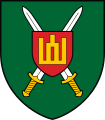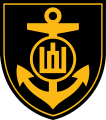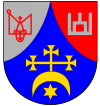Columns of Gediminas
| Columns of Gediminas Gediminids' Pillars | |
|---|---|
 | |
| Armiger | Grand Duchy of Lithuania, Republic of Lithuania, Sąjūdis |
| Adopted | It is absolutely certain that since 1397, the Gediminids' Pillars were Vytautas the Great's coat of arms. |
The Columns of Gediminas or Pillars of Gediminas (Lithuanian: Gediminaičių stulpai (Gediminids' Pillars); Belarusian: Калюмны (Columns)) are one of the earliest symbols of Lithuania and its historical coats of arms.[1] They were used in the Grand Duchy of Lithuania, initially as a rulers' personal insignia, a state symbol, and later as a part of heraldic signs of leading aristocracy.[1]
Appearance[]
The symbol appears in the following form: Horizontal line at bottom, vertical lines extend up at both ends. The Square at the middle of the horizontal line is about half as tall as the vertical lines. Another vertical line rises from the top center of the square, giving an overall appearance that is close to a trident. This form is the one usually seen in modern times, often drawn on walls and fences as protest against the Soviet occupation of Lithuania.
It is notable that the ancient pre-Christian symbols of Lithuania did not follow the same strict rules of heraldry as their western counterparts. Thus this symbol was used in Or and argent, usually on the field gules, and was depicted in various shapes on flags, banners and shields.
Name[]
The name "Columns of Gediminas" was given in the 19th century by historian Teodor Narbutt, who supposed that the symbol was Gediminas' insignia. The more exact name of the symbol is the Pillars of Gediminids, since there is no direct evidence of its connection with Grand Duke of Lithuania Gediminas.

History[]

In the Grand Duchy of Lithuania[]
According to the historical and archaeological evidence, the Columns were used by Grand Duke of Lithuania and Duke of Trakai Kęstutis. They appear on the Lithuanian coins issued by him.[2] The symbol was also used by Vytautas as his personal insignia since 1397 and appeared on his seal and coins.[3] It was suggested by historian Edmundas Antanas Rimša, who analyzed the ancient coins, that the Columns of the Gediminids symbolizes the Gates of the Trakai Peninsula Castle.[4] According to the accounts of Jan Długosz, it was derived from a symbol or brand used to mark horses and other property. The Columns were adopted by descendants of Kęstutis as their family symbol, equivalent to a coat of arms. Another user of the Columns of Gediminas was Grand Duke of Lithuania Sigismund Kęstutaitis. At first, the Columns signified the family of Kęstutis, in contrast to the Vytis which was used by Algirdas' descendants. Later on, as a symbol of a ruling dynasty, it was adopted by Jagiellons and the two symbols became state symbols of the Grand Duchy of Lithuania and the Columns of Gediminas remained in use over the following centuries.
In the Interwar Republic of Lithuania[]

During the period between World War I and World War II they were used by the Lithuanian Republic as a minor state symbol, e. g. on Litas coins and military equipment. The Columns of Gediminas are featured on the Lithuanian Presidential award Order of the Lithuanian Grand Duke Gediminas, that was started in 1928.
In the Soviet Union[]
After the annexation of Lithuania by the Soviet Union, the symbol was officially banned. During the Singing Revolution of the late 80s, it became the iconic sign of the reform movement Sąjūdis.
Modern usage in Lithuania[]
The Columns of Gediminas appears in the emblem of the Lithuanian Armed Forces, Land Force, Air Force, Navy, Military Police and National Defence Volunteer Forces.
- Use of the Columns of Gediniminas in modern Lithuania

By the Lithuanian Armed Forces.

By the Lithuanian Land Force.

By the Lithuanian Air Force.

By the Lithuanian Naval Force.

By the Lithuanian Military Police.
The official logo of the EuroBasket 2011, which took place in Lithuania, is composed of the Columns overlaid on a basketball board.
Usage in Belarus[]

The columns of Gediminas are occasionally used as a symbol of national pride in modern Belarus alongside the Pahonia coat of arms.[5][6][7][8]
It as also in the coat of arms of Brahin in southeastern Belarus.[9]
The symbol is featured on the monument to Duke Gediminas in Lida.[10][11]
In art[]
The Columns of Gediminas are displayed to the left of Jogaila in one of Jan Matejko's best-known portraits, although Jogaila's personal insignia was a double cross.

The columns of Gediminas are displayed on the flag to the left of Vytautas the Great
See also[]
| Wikimedia Commons has media related to Columns of Gediminas. |
- Coat of arms of Lithuania
- Gediminas' Tower
- House of Gediminas
- Polish heraldry
- Symbols of the Rurikids
- Tamga
References[]
- ^ a b "Columns of the Gediminids". Seimas. Retrieved 4 June 2021.
- ^ (in Lithuanian) Peculiarities of earliest Lithuanian coins
- ^ (in Lithuanian) Vilniaus Žemutinės pilies lobis – XIV a. pabaigos valstybinių bei valdovų atributų atspindys
- ^ Savukynas, Virginijus. "Kas slypi už tautinių simbolių?". DELFI (in Lithuanian). Prepared according to V. Savukynas telecast Tapatybės labirintai. Retrieved 3 April 2021.
- ^ Крыж, Пагоня ці Калюмны — які сымбаль яднае беларусаў? (галасаванка) [Cross, Pahonia or Columns: which symbol unites Belarusians? (Vote)] - Radio Svaboda, 5 September 2014
- ^ На Дзень Волі – у цішотцы з «Пагоняй» ад Віталя Гуркова [For Freedom Day, get a t-shirt with the Pahonia from Vital Hurkou] - Belsat, 08 March 2017. Quote: “«Мы хочам, каб Пагоня, Калюмны, магдэбургскія гербы гарадоў і мястэчак – багацце геральдычнай спадчыны нашага краю – сталі часткай культурнага кантэксту Беларусі.” [We want Pahonia, Kalumny, the Magedburg coats of arms of cities and towns, which form the richness of the heraldic tradition of our land - to become part of the cultural context of Belarus]
- ^ Партыю дызайнерскіх лідскіх красовак раскупілі за паўдня [A party of designer shoes from Lida were sold out within half a day] - European Radio for Belarus, 28 May 2018
- ^ «Первые свитшоты я распродал за час возле метро». Чем выделился этот бренд — история LSTR Adziennie [“I sold the first sweatshirts within an hour at the metro”. What is special about this brand - the history of LSRT Adziennie] - probusiness.io, 4 June 2018
- ^ Геральдыка [Heraldry] - official website of the administration of Brahin
- ^ В Лиде торжественно открыли памятник Гедимину [Monument to Gedymin officially unveiled in Lida] - European Radio for Belarus, 7 September 2019
- ^ Памятник князю Гедимину: ВКЛ становится брендом в Беларуси? [Monument to Duke Gedymin: the Grand Duchy of Lithuania becomes a brand in Belarus?] - LRT, 10 September 2019
Sources[]
- Valstybė. Iliustruota Lietuvos enciklopedija
- "Gediminas' Columns". Encyclopedia Lituanica II: 293. (1970–1978). Ed. Simas Sužiedėlis. Boston, Massachusetts: Juozas Kapočius. LCC 74-114275.
- National symbols of Lithuania
- National symbols of Belarus
- Heraldic charges






